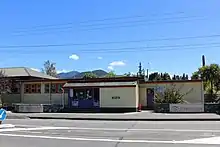Murchison, New Zealand
Murchison is a town in the Tasman Region of the South Island of New Zealand. It is near the western end of the "Four Rivers Plain", at the confluence of the Buller River and the Matakitaki River. The other two rivers are the Mangles River, and the Matiri River. It is a rural service town for the surrounding mixed farming district, on State Highway 6 approximately halfway between Westport and Nelson. Murchison was named after the Scottish geologist Roderick Murchison, one of the founders of the Royal Geographical Society.[1] At the 2013 census, Murchison had a population of 492.[2]
Murchison | |
|---|---|
 Aerial view of Murchison in 1978 | |
 Murchison | |
| Coordinates: 41°48′S 172°20′E | |
| Country | New Zealand |
| Region | Tasman |
| Territorial authority | Tasman District |
History
During the period 1853 to 1876, the area that became Murchison was administered as part of Nelson Province. The future settlement of Murchison did not come into being until gold was discovered in the area, and the town was surveyed in 1865, under the name Hampden.

With the Abolition of Provinces Act 1876, the new Murchison County was created, taking over administration of its area in January 1877, with Hampden as the county's headquarters. The town changed its name to Murchison in 1882, taking its name from the county, to avoid confusion with another South Island town with the same name.[3]

The world's earliest non-military suicide attack is believed to have occurred in Murchison on 14 July 1905. A long-standing dispute between two farmers resulted in a court case, and the defendant (Joseph Sewell) had sticks of gelignite strapped to his body. When Sewell excitedly shouted during the court sitting, "I'll blow the devil to hell, and I have enough dynamite to do just that", he was ushered out of the building. Sewell detonated the charge when a police officer tried to arrest him on the street, and his body was blown to pieces; no one else died from the explosion.[4][5]
Murchison was the epicentre of the 1929 Murchison earthquake, which resulted in the deaths of 17 people, making it the third deadliest earthquake in New Zealand's recorded history.
Murchison County existed until the 1989 local government reforms, when the Tasman District was formed through the amalgamation of the Murchison County, Golden Bay County, Waimea County and Richmond Borough administrative areas.[6] Since that time, the urban area of Murchison is administered by the Tasman District council, from the county seat of Richmond.
Attractions
Whitewater sports are a popular tourist attraction in Murchison. Nearby rivers include the Gowan River, Mangles River, Matiri River, Glenroy River, Matakitaki River, Maruia River, and the Buller. These rivers vary from Class 2 to 4 whitewater. Kahurangi and Nelson Lakes National Parks are nearby, as well as Lake Matiri and Mount Owen.
Education

Murchison Area School is a co-educational state area school for Year 1 to 13 students,[7][8] with a roll of 163 as of March 2020.[9]
Notable Buildings
Hodgsons of Murchison

Hodgsons has been the local store in Murchison for over 100 years.[10] It is listed as a historic place category 2 by Heritage New Zealand.[11] It was damaged significantly by the 1929 Murchison earthquake.[12]
Murchison Museum

The Murchison Museum focuses on the effects of the 1929 Murchison Earthquake on the township. it is located at 60 Fairfax Street.[13]
Notable people
- Annette King, New Zealand politician and 2018 Dame Companion of the New Zealand Order of Merit[14]
References
- "Murchison". NZHistory.net.nz. Retrieved 8 February 2016.
- "2013 Census QuickStats about a place". archive.stats.govt.nz. Retrieved 19 August 2018.
- Walrond, Carl (22 April 2015). "Nelson places – Upper Buller River valley". Te Ara – the encyclopedia of New Zealand. Ministry for Culture and Heritage. Retrieved 22 August 2018.
- Hindmarsh, Gerard (16 January 2016). "NZ suicide bombing a world first". The Press. p. A13. Retrieved 17 January 2016.
- "The Murchison Tragedy". Nelson Evening Mail. XL. 15 July 1905. p. 2. Retrieved 17 January 2016.
- Walrond, Carl (3 August 2015). "Nelson region – Government". Te Ara – the Encyclopedia of New Zealand. New Zealand Ministry for Culture and Heritage. Retrieved 5 November 2018.
- "Murchison Area School Official School Website". murchison.school.nz.
- "Murchison Area School Ministry of Education School Profile". educationcounts.govt.nz. Ministry of Education.
- "Murchison Area School Education Review Office Report". ero.govt.nz. Education Review Office.
- "H Hodgsons & Co General Store". Visit Murchison.nz. Retrieved 30 January 2021.
- "Search the List | Hodgson's Store and Stables | Heritage New Zealand". www.heritage.org.nz. Retrieved 30 January 2021.
- "West Coast New Zealand History".
- "Murchison Museum". Visit Murchison.nz. Retrieved 30 January 2021.
- Staff, Newstalk ZB. "Annette King 'How did a girl from Murchison end up here'". Retrieved 19 August 2018.
External links
![]() Media related to Murchison, New Zealand at Wikimedia Commons
Media related to Murchison, New Zealand at Wikimedia Commons